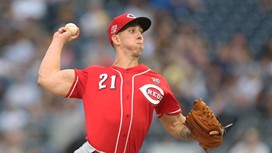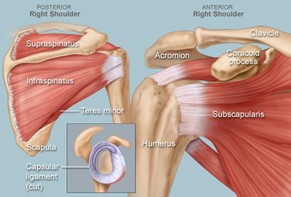
Whether you are rehabilitating the throwing shoulder, or looking at it from a prevention standpoint, the throwing shoulder needs a lot of love. Love your shoulder and, hopefully, it is going to love you back.
If you want it to love you back, you are going to need to give it the love it deserves, you know.
Maybe by:
- Making frequent thoughtful gestures;
- Ensuring proper communication;
- Spending some quality time together;
- Varying the type of activities that you enjoy and benefit you both
- Staying committed;
- Paying attention to details, etc.
Yeah, this shoulder rehab is a love story.
But let’s be serious. The bottom line is that once again, there’s more to rehabilitating the throwing shoulder than external rotation work! It takes a well-rounded approach.
When looking at the requirements of the throwing shoulder, there are multiple components:
Acceleration – Isometric and Concentric
Deceleration – Eccentric
And last but not least, timing!
However, we commonly see 2 things in rehab protocols: rehab focused solely on the rotator cuff, and rehab that stops at isolating the rotator cuff with concentric external rotation exercises.
Now, why is this bad, or at the very least, sub-optimal? For one, the best in the business use their big muscles to do big jobs, which means…not so much the cuff. Second, most of the hard work that the rotator cuff does is eccentric. And third, timing is everything.
Don’t get me wrong, the rotator cuff is extremely important. It needs to have a sufficient amount of strength to do its job properly. But what is its job? It’s job is to keep the humeral head centered within the glenoid/socket. It needs to work hard to “keep the golf ball on the tee”.
Do concentric rotator exercises help to achieve that task? As previously stated, the cuff needs a sufficient amount of strength to work adequately. Very often, early on, we’re going to need to reactivate a cuff that is inhibited or just weak. That’s part of a solid plan. However, a solid plan doesn’t stop there, especially for athletes who go through activities that require higher demands than people who are just happy to not be in pain when they grab the plates to serve dinner.
There is a significant gap between the two, and we need to bridge that gap.
Enjoyed this video? Make sure to subscribe to our YouTube channel!
A rotator cuff analogy
An important role of the cuff is to decelerate the arm’s powerful internal rotation and horizontal adduction. For example, the teres minor, which is a frequent source of isolated tenderness in pitchers, exhibits its maximum activity (84%MVIC) during deceleration (1) and most rotator cuff tears are located in mid-supraspinatus posterior to the mid-infraspinatus as a consequence of tensile failure (2).
It’s pretty simple. The more you accelerate, the more you need to decelerate.
For baseball players who perform the fastest movement of all sports by moving their shoulder as fast as 7000°/s, you can understand that there is a significant amount of force to absorb. In fact, it’s been measured to be as much as 1.5x bodyweight or around 1090N (3).
That’s means that another important role of the rotator cuff is to prevent distraction and anterior subluxation.
This concept of not only developing force, but absorbing it works very much like driving a car. You need the gas pedal as much as you need the brakes. If you only work on concentric strength, it’s like having a Ferrari without brakes! That makes no sense.
If you do have a Ferrari without brakes, you have two options. The safer option is to go at speed that you can handle. Consequently, you move more slowly because your body is going to protect itself at any cost. The other option is you crash your car; you tear something because you do not have the physical capacity to slow the movement.
Let the big guys do big jobs
The important thing to understand is that 1090N is probably too much for the cuff to handle on its own. The cuff is composed of small muscles. Important muscles, but small ones. Accepting this amount of force is a big job. Small muscles doing that big of a job… that’s going to be more taxing/stressful and not really sustainable.
I still like the Lord of the Rings reference for that one: “share the load”! Let the big guys do big jobs!
When we talk about the big guys, we’re talking about the latissimus dorsi, teres major, lower trapezius, and biceps brachii. The best pitchers are rarely sore mainly in their shoulder or their elbow. Most of the time, it’s the latissimus dorsi that takes the hit, and this is actually great news. The latissimus dorsi is the biggest muscle of the upper body and is heavily involved in both acceleration and deceleration. It comes at no surprise that professional players use their lats twice as much as amateur players. They let big muscles do big jobs, hence they are more efficient.
The teres major is the baby lat so, you can imagine that it’s going to be involved in the same way.
The lower fibers of the trapezius muscle record their highest activity in the deceleration phase to control protraction and upward rotation during the throw.
The biceps brachii has an important role, that of decelerating elbow extension. This prevents elbow issues such as the formation of osteophytes from elbow hyperextension.
However, the biceps brachii can become overactive to take over the cuff’s job of stabilizing the shoulder anteriorly. This could be a sign of shoulder instability and is not only inefficient (4), but can also be problematic in the long run.
Working on these big guys eccentrically is a big part of building the bulletproof suburban that we want.
Exercises such as the self-flip and catch, and the partner reverse throw are going to specifically increase the demand on the cuff and the scapular muscles, as well as the lats/teres major.
MAKE SURE TO WATCH THE MAIN VIDEO OF THE ARTICLE TO SEE HOW THESE EXERCISES ARE DONE
Take some driving lessons
It’s a good start to have a powerful engine in a bulletproof car that has great brakes. However, you need to know how to drive the car. Driving lessons for the shoulder are going to involve timing!
The cuff has to react to many smaller and larger movements to “keep the golf ball on the tee”. This requires precision. Think of it like the eye muscles, which need to perform very precise movements. It’s about applying the right amount of force, at the right place, at the right time in response to a given stimulus.
The athletic environment can be very chaotic, such as in boxing when punching or in judo when throwing and grabbing an opponent, making the reactive component a huge factor to consider in rehab.
Throwing something with lower intensity in a “same but different” way is a great introduction to distraction forces and timing that comes with it. It’s like the first driving lesson, it “gets your feet wet” and helps you gain confidence.
The med ball push exercise is a great way to progress to distraction forces and timing. As the med ball is released, the cuff needs to react appropriately in order to act as a suction cup to keep the humeral head in the glenoid.
The rotator cuff is extremely important, and while isolation exercises are part of a solid plan, the plan cannot stop there. The small, precise muscles of the cuff need to be trained that way, with timing in mind. They also need to work together with the big muscles who do the big jobs. Share the load.
Rehabilitating the throwing shoulder requires a plan that involves ensuring there is sufficient concentric and isometric strength of the cuff, working on timing and building eccentric strength.
And don’t forget that this is a love story.
References
1. Escamilla RF, Andrews JR. Shoulder muscle recruitment patterns and related biomechanics during upper extremity sports. Sports Med Auckl NZ. 2009;39(7):569-590. doi:10.2165/00007256-200939070-00004
2. Andrews JR, Angelo RL. Shoulder arthroscopy for the throwing athlete. Tech Orthop. 1988;3(1):75-82.
3. Fleisig GS, Andrews JR, Dillman CJ, Escamilla RF. Kinetics of baseball pitching with implications about injury mechanisms. Am J Sports Med. 1995;23(2):233-239. doi:10.1177/036354659502300218
4. Gowan ID, Jobe FW, Tibone JE, Perry J, Moynes DR. A comparative electromyographic analysis of the shoulder during pitching. Professional versus amateur pitchers. Am J Sports Med. 1987;15(6):586-590. doi:10.1177/036354658701500611
Marc-Antoine Bérubé
in collaboration with Mai-Linh Dovan M.SC., CAT(C)
Marc-Antoine has been involved in baseball for many years. He played within Baseball Québec’s structure, at Northeastern Oklahoma A&M College and the University of Pittsburgh. In 2015, he was selected in the MLB Draft by the Oakland Athletics. Since retiring, Marc-Antoine has been transmitting his passion to young prospects as the pitching coach for the Académie Baseball Canada.






… [Trackback]
[…] Read More to that Topic: rehab-u.com/rehabilitating-the-throwing-shoulder/ […]
… [Trackback]
[…] Info to that Topic: rehab-u.com/rehabilitating-the-throwing-shoulder/ […]
… [Trackback]
[…] Here you can find 48406 additional Info to that Topic: rehab-u.com/rehabilitating-the-throwing-shoulder/ […]
… [Trackback]
[…] Find More on that Topic: rehab-u.com/rehabilitating-the-throwing-shoulder/ […]
… [Trackback]
[…] Find More on on that Topic: rehab-u.com/rehabilitating-the-throwing-shoulder/ […]
… [Trackback]
[…] Find More to that Topic: rehab-u.com/rehabilitating-the-throwing-shoulder/ […]
… [Trackback]
[…] There you will find 94518 more Info to that Topic: rehab-u.com/rehabilitating-the-throwing-shoulder/ […]
… [Trackback]
[…] Info on that Topic: rehab-u.com/rehabilitating-the-throwing-shoulder/ […]
… [Trackback]
[…] Find More on to that Topic: rehab-u.com/rehabilitating-the-throwing-shoulder/ […]
… [Trackback]
[…] Find More Information here on that Topic: rehab-u.com/rehabilitating-the-throwing-shoulder/ […]
… [Trackback]
[…] Info to that Topic: rehab-u.com/rehabilitating-the-throwing-shoulder/ […]
… [Trackback]
[…] Information to that Topic: rehab-u.com/rehabilitating-the-throwing-shoulder/ […]
… [Trackback]
[…] Read More Information here to that Topic: rehab-u.com/rehabilitating-the-throwing-shoulder/ […]
… [Trackback]
[…] Find More here on that Topic: rehab-u.com/rehabilitating-the-throwing-shoulder/ […]
… [Trackback]
[…] Find More on on that Topic: rehab-u.com/rehabilitating-the-throwing-shoulder/ […]
… [Trackback]
[…] Information to that Topic: rehab-u.com/rehabilitating-the-throwing-shoulder/ […]
… [Trackback]
[…] Find More Information here on that Topic: rehab-u.com/rehabilitating-the-throwing-shoulder/ […]
… [Trackback]
[…] Info to that Topic: rehab-u.com/rehabilitating-the-throwing-shoulder/ […]
… [Trackback]
[…] There you will find 97770 additional Info on that Topic: rehab-u.com/rehabilitating-the-throwing-shoulder/ […]
… [Trackback]
[…] Read More on that Topic: rehab-u.com/rehabilitating-the-throwing-shoulder/ […]
… [Trackback]
[…] Find More on to that Topic: rehab-u.com/rehabilitating-the-throwing-shoulder/ […]
… [Trackback]
[…] Read More on on that Topic: rehab-u.com/rehabilitating-the-throwing-shoulder/ […]
… [Trackback]
[…] Find More Information here on that Topic: rehab-u.com/rehabilitating-the-throwing-shoulder/ […]